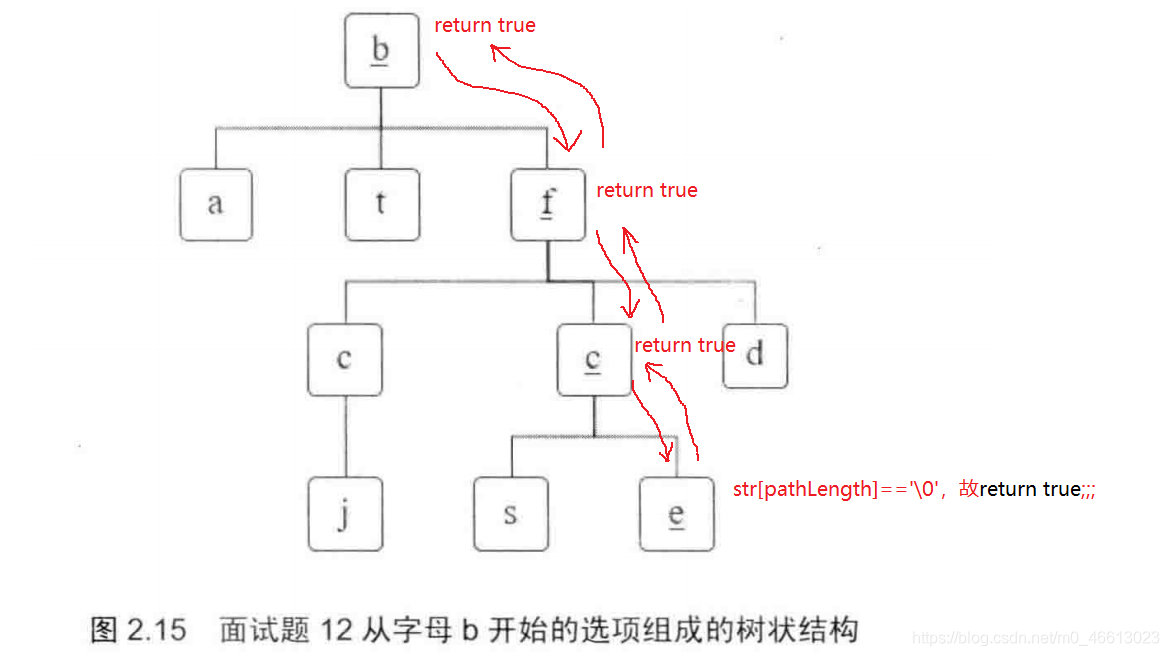面试题12:矩阵中的路径
请设计一个函数,用来判断在一个矩阵中是否存在一条包含某字符串所有字符的路径。
路径可以从矩阵中的任意一格开始,每一步可以在矩阵中向左、右、上、下移动一格。如果一条路径经过了矩阵的某一格 那么该路径不能再次进入该格子。

#include <cstdio>
#include <string>
#include <stack>
using namespace std;
bool hasPathCore(const char* matrix, int rows, int cols, int row,
int col, const char* str, int& pathLength, bool* visited)
{
// 此时路径字符串上的所有字符都在矩阵中找到合适的位置
if (str[pathLength] == '\0')
return true;
// 判断当前矩阵字符前,先将hasPath置为false
bool hasPath = false;
// 此时路径字符串上待判断的字符 == 当前矩阵字符 且 当前矩阵字符没有被使用
if (row >= 0 && row < rows && col >= 0 && col < cols
&& matrix[row * cols + col] == str[pathLength]
&& !visited[row * cols + col])
{
// 开始遍历路径字符串上下一个字符
++pathLength;
// 将刚才已确定的字符在布尔值矩阵置为true,防止下次遍历被重复使用
visited[row * cols + col] = true;
// 围绕着当前已确定的字符,开始判断上下左右四个方向新的矩阵字符
hasPath = hasPathCore(matrix, rows, cols, row, col - 1,
str, pathLength, visited)
|| hasPathCore(matrix, rows, cols, row - 1, col,
str, pathLength, visited)
|| hasPathCore(matrix, rows, cols, row, col + 1,
str, pathLength, visited)
|| hasPathCore(matrix, rows, cols, row + 1, col,
str, pathLength, visited);
// hasPath==0:已确定的字符的上下左右四个方向新的矩阵字符均不符合要求
// 证明当前路径不符合要求
// 只能回退到上一个字符重新遍历
if (!hasPath)
{
--pathLength;
visited[row * cols + col] = false;
}
}
return hasPath;
}
bool hasPath(const char* matrix, int rows, int cols, const char* str)
{
if (matrix == nullptr || rows < 1 || cols < 1 || str == nullptr)
return false;
// 布尔值矩阵:用来标识路径是否已经进入了每个格子
bool* visited = new bool[rows * cols];
memset(visited, 0, rows * cols);
int pathLength = 0;
// 以矩阵中每一个字符为起点而产生的路径与str进行匹配
for (int row = 0; row < rows; ++row)
{
for (int col = 0; col < cols; ++col)
{
if (hasPathCore(matrix, rows, cols, row, col, str,
pathLength, visited))
{
return true;
}
}
}
delete[] visited;
return false;
}
void Test(const char* testName, const char* matrix, int rows,
int cols, const char* str, bool expected)
{
if (testName != nullptr)
printf("%s begins: ", testName);
if (hasPath(matrix, rows, cols, str) == expected)
printf("Passed.\n");
else
printf("FAILED.\n");
}
//ABTG
//CFCS
//JDEH
//BFCE
void Test1()
{
const char* matrix = "ABTGCFCSJDEH";
const char* str = "BFCE";
Test("Test1", (const char*)matrix, 3, 4, str, true);
}
//ABCE
//SFCS
//ADEE
//SEE
void Test2()
{
const char* matrix = "ABCESFCSADEE";
const char* str = "SEE";
Test("Test2", (const char*)matrix, 3, 4, str, true);
}
int main()
{
Test1();
Test2();
return 0;
}
面试题13:机器人的运动范围
地上有一个m行n列的方格。一个机器人从坐标(0,0)的格子开始移动,它每次可以向左、右、上、下移动一格,但不能进入行坐标和列坐标的数位之和大于k的格子。
例如,当k为18时,机器人能够进入方格(35,37),因为3+5 +3+7=18,但它不能进入方格(35,38),因为3+5+3+8=19。
请问该机器人能够到达多少个格子?
int getDigitSum(int number)
{
int sum = 0;
while (number > 0)
{
sum += number % 10;
number /= 10;
}
return sum;
}
int movingCountCore(int threshold, int rows, int cols, int row, int col, bool* visited)
{
int count = 0;
if (row >= 0 && row < rows && col >= 0 && col < cols
&& getDigitSum(row) + getDigitSum(col) <= threshold
&& !visited[row * cols + col])
{
visited[row * cols + col] = true;
count = 1 + movingCountCore(threshold, rows, cols, row - 1, col, visited)
+ movingCountCore(threshold, rows, cols, row, col - 1, visited)
+ movingCountCore(threshold, rows, cols, row + 1, col, visited)
+ movingCountCore(threshold, rows, cols, row, col + 1, visited);
}
return count;
}
int movingCount(int threshold, int rows, int cols)
{
if (threshold < 0 || rows <= 0 || cols <= 0)
return 0;
bool* visited = new bool[rows * cols];
memset(visited, 0, rows * cols);
int count = movingCountCore(threshold, rows, cols, 0, 0, visited);
delete[] visited;
return count;
}
int main()
{
int step = movingCount(5, 10, 10);
cout << step << endl;
// 答案:21
return 0;
}